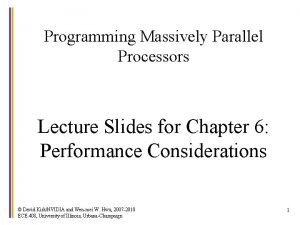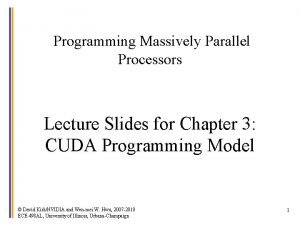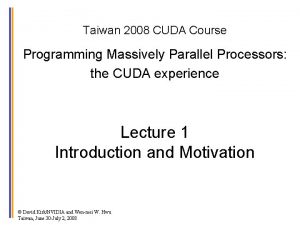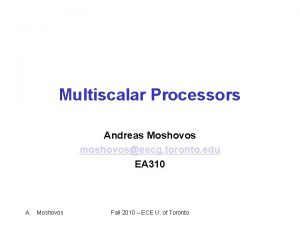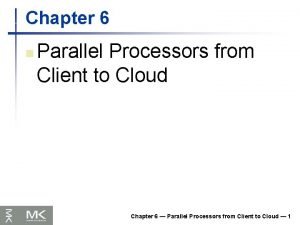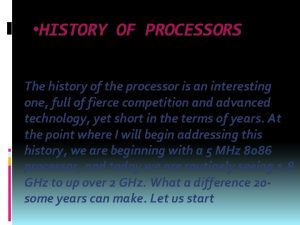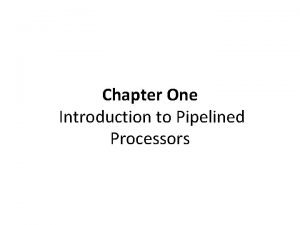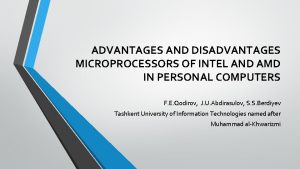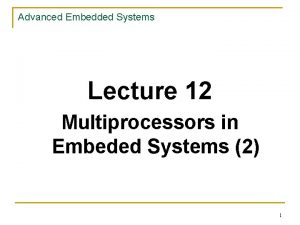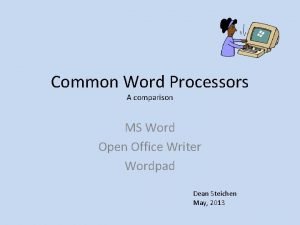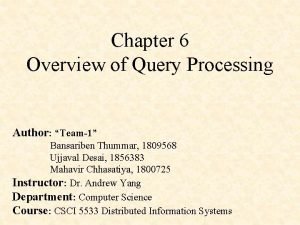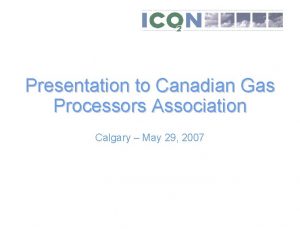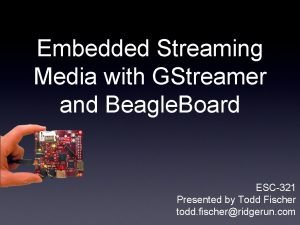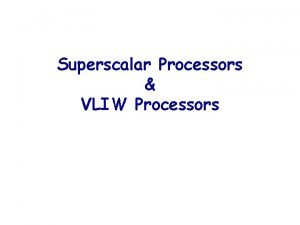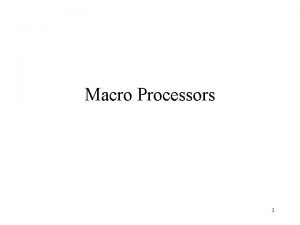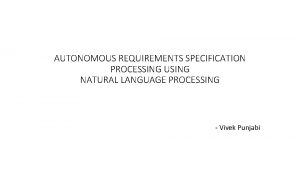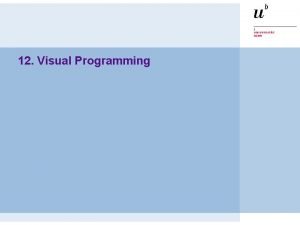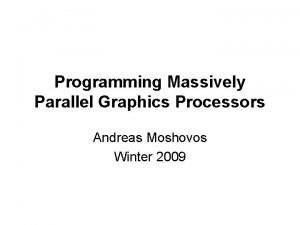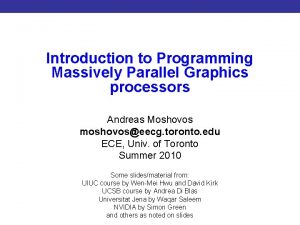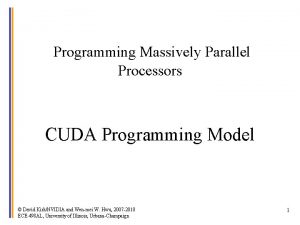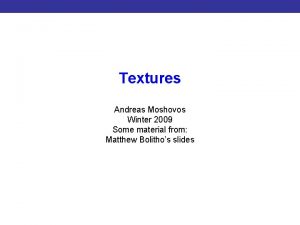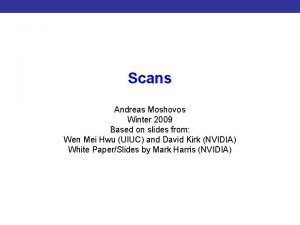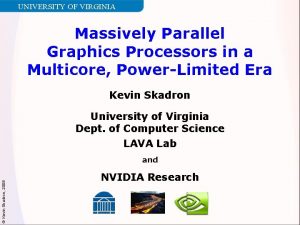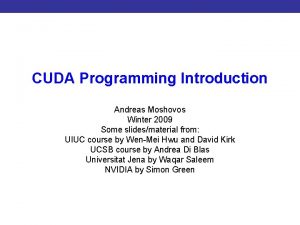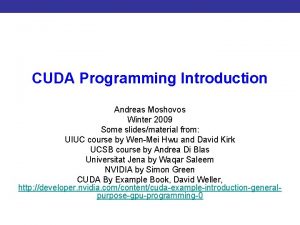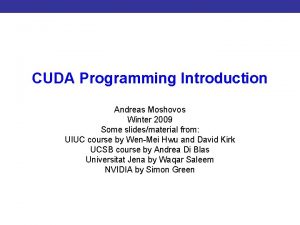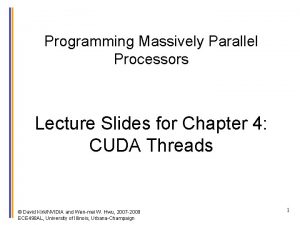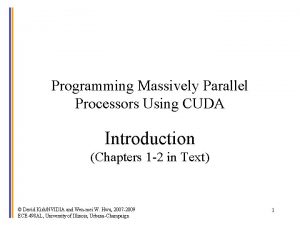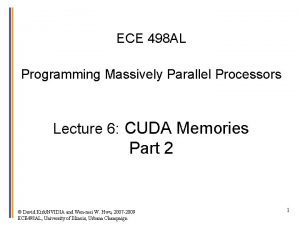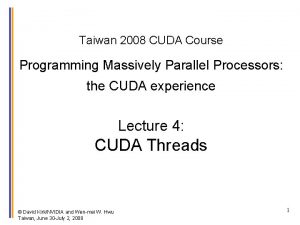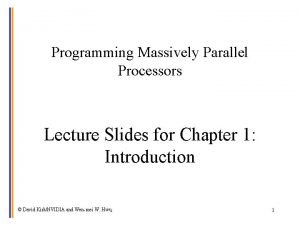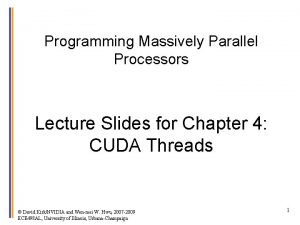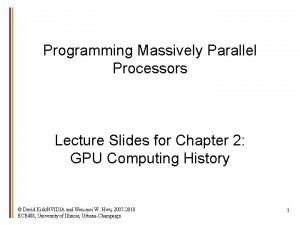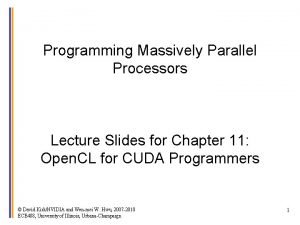Programming Massively Parallel Graphics Processors Andreas Moshovos Winter



![• Sequential Execution Model int a[N]; // N is large for (i =0; • Sequential Execution Model int a[N]; // N is large for (i =0;](https://slidetodoc.com/presentation_image_h/d822c9e8a3872084f2a81cbcff41a8aa/image-4.jpg)
![• Data Parallel Execution Model / SIMD int a[N]; // N is large • Data Parallel Execution Model / SIMD int a[N]; // N is large](https://slidetodoc.com/presentation_image_h/d822c9e8a3872084f2a81cbcff41a8aa/image-5.jpg)
![• Single Program Multiple Data / SPMD int a[N]; // N is large • Single Program Multiple Data / SPMD int a[N]; // N is large](https://slidetodoc.com/presentation_image_h/d822c9e8a3872084f2a81cbcff41a8aa/image-6.jpg)























- Slides: 29

Programming Massively Parallel Graphics Processors Andreas Moshovos Winter 2009

• Goals: – Graphics Processors – Learn how program GPUs – Learn how to get performance out of GPUs • Understand GPU architecture and limitations – CUDA: Compute Unified Device Architecture/NVidia • How: – Weekly assignments for the first few weeks – A large team project • Ideal Scenario: – Non-ECE Non-CS people will team up with CS/ECE and attack an interesting problem

• What is a GPU – Specialized processor for graphics – Embarrassingly parallel: • Lots of: – Read data, calculate, write – Used to be fixed function – Are becoming more programmable • What is CUDA – A C extension for programming for NVIDIA GPUs – Straightforward to learn – Challenge is in getting performance
![Sequential Execution Model int aN N is large for i 0 • Sequential Execution Model int a[N]; // N is large for (i =0;](https://slidetodoc.com/presentation_image_h/d822c9e8a3872084f2a81cbcff41a8aa/image-4.jpg)
• Sequential Execution Model int a[N]; // N is large for (i =0; i < N; i++) time a[i] = a[i] * fade; Flow of control / Thread One instruction at the time Optimizations possible at the machine level
![Data Parallel Execution Model SIMD int aN N is large • Data Parallel Execution Model / SIMD int a[N]; // N is large](https://slidetodoc.com/presentation_image_h/d822c9e8a3872084f2a81cbcff41a8aa/image-5.jpg)
• Data Parallel Execution Model / SIMD int a[N]; // N is large for all elements do in parallel time a[index] = a[index] * fade;
![Single Program Multiple Data SPMD int aN N is large • Single Program Multiple Data / SPMD int a[N]; // N is large](https://slidetodoc.com/presentation_image_h/d822c9e8a3872084f2a81cbcff41a8aa/image-6.jpg)
• Single Program Multiple Data / SPMD int a[N]; // N is large for all elements do in parallel time if (a[i] > threshold) a[i]*= fade;

• Programmer’s view – Typical System If you care about performance a lot CPU regs caches 12. 8 GB/sec – 31. 92 GB/sec 8 B per transfer Memory

• Programmer’s view with GPU CPU 3 GB/s GPU 141 GB/sec 12. 8 GB/sec – 31. 92 GB/sec 8 B per transfer Memory GPU Memory 1 GB on our systems

• Programmer’s view with GPU Copy to GPU mem Launch GPU threads time Synchronize with GPU Copy from GPU mem GPU

• Structure: CPU vs. GPU

• But what about performance? • Focus on PEAK performance first: – What the manufacturer guarantees you’ll never exceed • Two Aspects: – Data Access Rate Capability • Bandwidth – Data Processing Capability • How many ops per sec

• Data Processing Capability – Focus on floating point data • GFLOPS – Billion Floating-Point Operations per Second – Caveat: FOPs can be different • But today things are not as bad as before • High-End CPU today – 3. 4 Ghz x 8 FOPS/cycle = 27 GFLOPS – Assumes SSE • High-End GPU today / GTX 280 – 933. 1 GFLOPS or 34 x capability

• Data Access Capability • High-End CPU Today – 31. 92 GB/sec (nehalem) - 12. 8 GB/sec (hapertown) – Bus width 64 -bit • GPU / GTX 280 – 141. 7 GB/sec – Bus width 512 -bit – 4. 39 x – 11 x

• GPU vs. CPU

• GPU vs. CPU

• What the programmer needs to know? • Many details about the architecture • But fortunately most of it is simple

• Programmer’s view: GPU Architecture

• My first CUDA Program __global__ void arradd (float *a, float f, int N) { int i = block. Idx. x * block. Dim. x + thread. Idx. x; if (i < N) a[i] = a[i] + float; } GPU int main() { float h_a[N]; float *d_a; cuda. Malloc ((void **) &a_d, SIZE); CPU cuda. Thread. Synchronize (); cuda. Memcpy (d_a, h_a, SIZE, cuda. Memcpy. Host. To. Device)); arradd <<< n_blocks, block_size >>> (d_a, 10. 0, N); cuda. Thread. Synchronize (); cuda. Memcpy (h_a, d_a, SIZE, cuda. Memcpy. Device. To. Host)); CUDA_SAFE_CALL (cuda. Free (a_d)); }

• Threads / Blocks / Grid Block size = 12 #blocks = 5 Block 0: a[0]…a[11] … Block 4: a[48]. . a[59] a[48] a[59]

• Memory Hierarchy Anything declared inside The kernel __shared__ int… __global__ int…

• Performance Programmer’s view Mark Silberstein, Technion

• CUDA keywords, etc. • Declspecs – global, device, shared, local, constant __device__ float filter[N]; __global__ void convolve (float *image) __shared__ float region[M]; . . . • Keywords region[thread. Idx] = image[i]; – thread. Idx, block. Idx • Intrinsics __syncthreads(). . . – __syncthreads image[j] = result; } • Runtime API – Memory, symbol, execution management • Function launch // Allocate GPU memory void *myimage = cuda. Malloc(bytes) cuda. Thread. Synchronize (); // 100 blocks, 10 threads per block convolve<<<100, 10>>> (myimage); {

• Floating-Point Caveats • Single precisions floating point support is not 100% IEEE 754 – No denormals, fixed rounding modes – Must check that SNR remains acceptable – But there are lots of SP FP units • GTX 280 supports double precision – But there are very few of these units

• Development Process • Course Specific • Get an account on the eecg network – Fill in your name/ID/current e-mail on the list • Wait until confirmation is received • Machines – ug 51. eecg through ug 75. eecg. utoronto. ca – SF 2204 – Keycode: _______

• • • Development Process Once you are on ugxx machine source /cad 1/CUDA/cuda. csh That will create a NVIDIA_CUDA_SDK Go in and type “make dbg=1” This builds several examples under bin/linux/debug • The source code is in the projects subdir • We’ll post a handout soon on the course website

• • • Development Process Create a xxxx. cu file Compile it with nvcc Makefile is provided by the SDK Nvcc is a preprocessor

• So, why would Parallel Processing work? • Parallel Processing and Programming has been around for a while • Golden age was the 80 s • Didn’t work – Programming is hard – Hardware was expensive – Single processor performance was doubling every 18 months • Why would it work now? – Cost / Single processor • Not a done deal at all Programming is still hard

• Course Staff • • Andreas Moshovos EA 310, 416 -946 -7373 moshovos@eecg. toronto. edu www. eecg. toronto. edu/~moshovos TA Hassan Shojania hassan@eecg. toronto

• Course Structure • Till the end of February / weekly assignments – CUDA programming – GTX 280 architecture – CUDA performance – Floating Point • March / Project Proposal and work – Case studies – General Parallel Programming guidelines • April – Project Presentations • Make up lectures?
 Programming massively parallel processors
Programming massively parallel processors Programming massively parallel processors
Programming massively parallel processors Massively parallel processing ppt
Massively parallel processing ppt Programming massively parallel processors, kirk et al.
Programming massively parallel processors, kirk et al. Andreas moshovos
Andreas moshovos Parallel processors from client to cloud
Parallel processors from client to cloud Winter kommt winter kommt flocken fallen nieder
Winter kommt winter kommt flocken fallen nieder Winter kommt flocken fallen nieder
Winter kommt flocken fallen nieder Meine lieblingsjahreszeit ist der winter
Meine lieblingsjahreszeit ist der winter Graphics monitors in computer graphics
Graphics monitors in computer graphics Computer graphics introduction ppt
Computer graphics introduction ppt Difference between linear and nonlinear pipeline
Difference between linear and nonlinear pipeline Interrupt handling in arm processors
Interrupt handling in arm processors Processor history
Processor history Unifunction and multifunction pipeline
Unifunction and multifunction pipeline Digital camera processors
Digital camera processors Microprocessor advantages and disadvantages
Microprocessor advantages and disadvantages Embeded processors
Embeded processors Embedded innovator winter 2010
Embedded innovator winter 2010 Comparison of word processors
Comparison of word processors Distributed query processing
Distributed query processing Gas processors association
Gas processors association Gstreamer architecture
Gstreamer architecture Ece 526
Ece 526 Two pass macro processor algorithm
Two pass macro processor algorithm Difference between vliw and superscalar processor
Difference between vliw and superscalar processor Macro processors
Macro processors Language and processors for requirement
Language and processors for requirement Introduction of telecommunication
Introduction of telecommunication Realitykit example
Realitykit example

